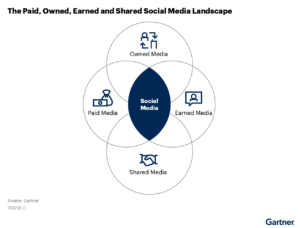Consumers’ time on social media has spiked since the COVID-19 outbreak and users are absorbing more digital content than ever before. In fact, Gartner research shows 80% of consumers in the U.S. and U.K. are consuming more social and digital content since the beginning of the pandemic.
Social media marketing is a complex landscape, where consumer expectations of a consistent and seamless journey often clash with disjointed social planning approaches. This is heightened by the lack of data transparency from social platforms and continuously changing algorithms.

1. Develop the guidelines and processes needed for a consistent brand presence
-
- Consumers also demand consistency from brands, which must be intentionally planned and orchestrated, even where ownership of social media channel communications is disjointed.
- The key to a successful content pipeline is to plan smarter to ensure the right content, on the right channel, in the right format and at the right time.
- Break down the silos across your social teams and beyond. Host weekly (or daily) stand-ups to ensure that what you want to say is still relevant. Use shared editorial calendars so teams have a view on planning and publishing.
2. Engage and empower your community to create their own content
-
- Be part of the conversation that matters to your customers. Listen to your customers. If they want to talk about environmental sustainability, then talk with them about environmental sustainability.
- Give your customers a voice in your brand and leverage UGC to build trust. People want to hear about how great your brand is from other people, not from you.
- Explore which influencers are right for you and why. Can they help you reach diverse audiences; do they create fantastic content?
3. Facilitate the connections that capture attention
-
- Aligning social media throughout the entire customer journey helps to reinforce that your brand is authentic and dependable, which is more important now than ever in times of uncertainty.
- Consider how far your customers can get in social. They can’t always buy on-platform, plan content and CTAs to help them get closer to a decision before trying to drive them to your website or retail partner.
4. Help your customers achieve their goals
-
- Brand-engaged consumers, those who use a given platform at least once a week, say they like seeing content from brands and follow brands on that platform, doubled from 10% of all users in January 2019 to 20% in April 2021.
- Give them content that is helpful – that speaks to there needs and pain points. The greatest opportunity in social is that you can be really specific to the needs of your customers. You can also quickly test and optimize content to ensure that it keeps resonating.
There are more people on social media than in the past and these users are creating more content than ever before. As a result, your brand needs to provide entertainment, utility, conversation, or some combination of the three to remain relevant to consumers. You need to support a consistent experience across social, and the multichannel journey, to build trust and help your customers achieve their goals while driving your business objectives. Gartner clients can learn more from Gartner’s Guide to Social Marketing Content Across Paid, Owned, Earned and Shared.
[“source=gartner”]






















































